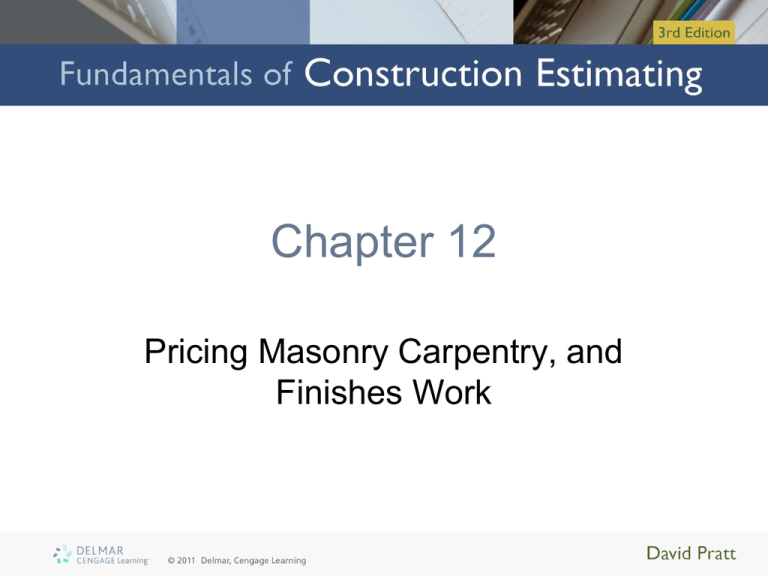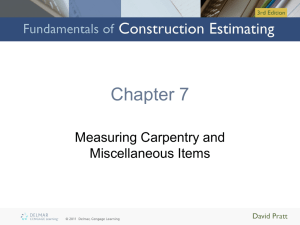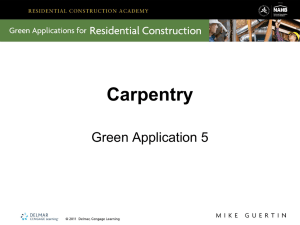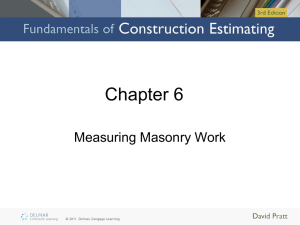Chapter 12: PRICING Masonry, Carpentry, and Finishes Work
advertisement

Chapter 12 Pricing Masonry Carpentry, and Finishes Work Objectives • Upon completion of this chapter, you will be able to: – Describe the specific job factors that affect the price of masonry work – Explain what influences the material price of masonry bricks and blocks – Describe the specific job factors that affect the price of rough carpentry work Objectives (cont’d.) – Explain what influences the material price of lumber – Describe how finish carpentry is priced – Describe how interior and exterior finishes are priced Objectives (cont’d.) – Complete the recap and pricing of masonry work, rough carpentry, finish carpentry, and interior and exterior finishes using manual methods – Use Excel spreadsheets to price masonry work Introduction • Masonry work, rough carpentry, and finish carpentry – Commonly subcontracted – Still performed by some contractors • Specialized companies – May have questionable reliability record • Price errors Masonry • Labor costs – Laying masonry – Installing accessories • Ladder reinforcing and wall ties • Masonry materials • Modularization – Factory construction of masonry panels • Not common Masonry Productivity • Factors affecting productivity: – What is being built – Workmanship required – Size and weights of units – Mortar and bond used – Design complexity – Presence or lack of repetition – Availability of skilled trade workers Figure 12.1 Masonry Work Productivities (Delmar/Cengage Learning) Masonry Materials • Prices vary – Depend on requirements – Normally found in specifications • When not provided, based on materials agreed upon (e.g., materials defined in the bid) • Wastage – More materials delivered than used • Accounted for in takeoff quantities Rough Carpentry • Fabricated off-site – Assembled at the job site • Costs – Labor and material • • • • Lumber or fabricated components Cranes Beams Trusses Rough Carpentry Productivity • Factors affecting productivity: – Carpentry components – Size of cross-section and length lumber – Power tool use – Design complexity – Presence or lack of repetition – Off-site fabrication Rough Carpentry Materials • Specifications define: – Species – Use classification – Lumber grade • Softwood lumbar classifications: – Yard, structural, factory, and shop lumber – Rough, surfaced, and worked lumber – Boards, dimension, and timber Rough Carpentry Materials (cont’d.) • Lumber lengths and waste factors – Generally multiples of two feet • Waste factors still required • Lumber grades – Information on ability to meet requirements • Rough hardware – Mostly consists of nails • Other fasteners may also be required Finish Carpentry and Millwork • Pricing finish carpentry – Applying materials and labor prices to items measured in takeoff process • Productivity of labor crews – Influenced by job factors • Similar to rough carpentry Exterior and Interior Finishes • Procedure: – Measure quantity of each item of in takeoff – List takeoff items on a recap – Apply separate materials and labor prices • Material prices: – Determined by suppliers • Productivities: – Job, labor, and management factors Wage Rates • Basic hourly wages: – Masonry foreman: $43.00 – Mason: $39.00 – Equipment operator: $40.00 – Labor foreman: $33.00 – Laborer: $30.00 Wage Rates (cont’d.) – Cement finisher: $37.00 – Carpentry foreman: $41.00 – Carpenter: $38.00 – Painter foreman: $37.00 – Painter: $34.00 Examples • Masonry, Rough Carpentry and Finish Carpentry Recap and Pricing Notes Example 1—House – Refer to Figures 12.6 through 12.10 • Masonry Work Pricing Notes Example 2—Office/Warehouse Building – Refer to Figure 12.11 Summary • This chapter reviewed pricing and influential pricing factors of: – Masonry work – Rough carpentry work – Finish carpentry work – Interior and exterior finishes










